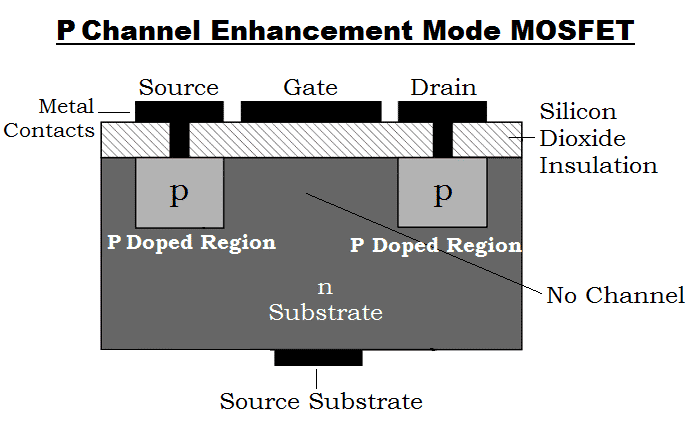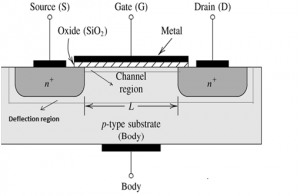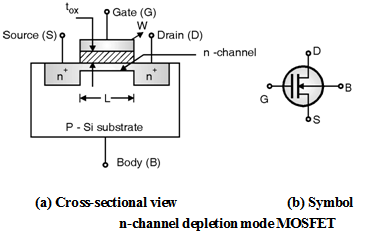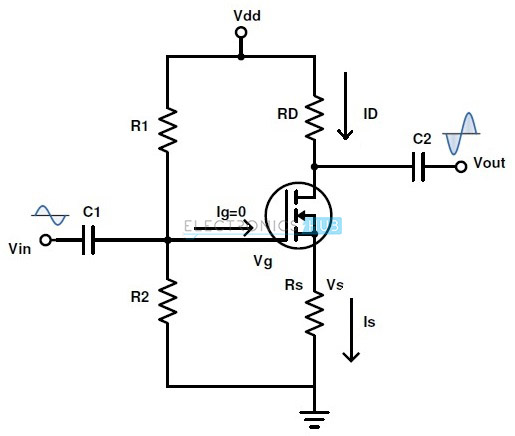- Basic Electronics Tutorial
- Electronic Components
- Resistors
Because, P type mosfet or transistor switch – on with Low, N type Mosfet or transistor switch- on with High signals! When you connect their bases or gates, since they have not resistance in between, they do complete the circuit and both are actively carrying current! So motor will get nothing!
- Capacitors
- With an N type MOSFET you let the current flow from the drain through the source when a high enough voltage is applied to the gate. With a P type MOSFET which direction is the current meant to flow.
- Apr 03, 2019 In this type of MOSFET, all the construction of MOSFET is almost the same as p channel type MOSFET. But here channel created between drain and source is an n-type channel. Here drain and source are as n-type semiconductors and body (substrate ) is p type semiconductor.
- Inductors
- Transformers
- Diodes
- Transistors
- Basic Electronics Useful Resources
- Selected Reading
FETs have a few disadvantages like high drain resistance, moderate input impedance and slower operation. To overcome these disadvantages, the MOSFET which is an advanced FET is invented.
MOSFET stands for Metal Oxide Silicon Field Effect Transistor or Metal Oxide Semiconductor Field Effect Transistor. This is also called as IGFET meaning Insulated Gate Field Effect Transistor. The FET is operated in both depletion and enhancement modes of operation. The following figure shows how a practical MOSFET looks like.
Construction of a MOSFET
The construction of a MOSFET is a bit similar to the FET. An oxide layer is deposited on the substrate to which the gate terminal is connected. This oxide layer acts as an insulator (sio2 insulates from the substrate), and hence the MOSFET has another name as IGFET. In the construction of MOSFET, a lightly doped substrate, is diffused with a heavily doped region. Depending upon the substrate used, they are called as P-type and N-type MOSFETs.
The following figure shows the construction of a MOSFET.
The voltage at gate controls the operation of the MOSFET. In this case, both positive and negative voltages can be applied on the gate as it is insulated from the channel. With negative gate bias voltage, it acts as depletion MOSFET while with positive gate bias voltage it acts as an Enhancement MOSFET.
Classification of MOSFETs

Mosfet P Type Current
Depending upon the type of materials used in the construction, and the type of operation, the MOSFETs are classified as in the following figure.
After the classification, let us go through the symbols of MOSFET.
The N-channel MOSFETs are simply called as NMOS. The symbols for N-channel MOSFET are as given below.
The P-channel MOSFETs are simply called as PMOS. The symbols for P-channel MOSFET are as given below.
Now, let us go through the constructional details of an N-channel MOSFET. Usually an NChannel MOSFET is considered for explanation as this one is mostly used. Also, there is no need to mention that the study of one type explains the other too.
Construction of N- Channel MOSFET
Let us consider an N-channel MOSFET to understand its working. A lightly doped P-type substrate is taken into which two heavily doped N-type regions are diffused, which act as source and drain. Between these two N+ regions, there occurs diffusion to form an Nchannel, connecting drain and source. Bloons super monkeywatermelon gaming.
A thin layer of Silicon dioxide (SiO2) is grown over the entire surface and holes are made to draw ohmic contacts for drain and source terminals. A conducting layer of aluminum is laid over the entire channel, upon this SiO2 layer from source to drain which constitutes the gate. The SiO2 substrate is connected to the common or ground terminals.
Because of its construction, the MOSFET has a very less chip area than BJT, which is 5% of the occupancy when compared to bipolar junction transistor. This device can be operated in modes. They are depletion and enhancement modes. Let us try to get into the details.
Working of N - Channel (depletion mode) MOSFET
For now, we have an idea that there is no PN junction present between gate and channel in this, unlike a FET. We can also observe that, the diffused channel N (between two N+ regions), the insulating dielectric SiO2 and the aluminum metal layer of the gate together form a parallel plate capacitor.
If the NMOS has to be worked in depletion mode, the gate terminal should be at negative potential while drain is at positive potential, as shown in the following figure.
When no voltage is applied between gate and source, some current flows due to the voltage between drain and source. Let some negative voltage is applied at VGG. Then the minority carriers i.e. holes, get attracted and settle near SiO2 layer. But the majority carriers, i.e., electrons get repelled.

With some amount of negative potential at VGG a certain amount of drain current ID flows through source to drain. When this negative potential is further increased, the electrons get depleted and the current ID decreases. Hence the more negative the applied VGG, the lesser the value of drain current ID will be.
The channel nearer to drain gets more depleted than at source (like in FET) and the current flow decreases due to this effect. Hence it is called as depletion mode MOSFET.
Working of N-Channel MOSFET (Enhancement Mode)
The same MOSFET can be worked in enhancement mode, if we can change the polarities of the voltage VGG. So, let us consider the MOSFET with gate source voltage VGG being positive as shown in the following figure.
When no voltage is applied between gate and source, some current flows due to the voltage between drain and source. Let some positive voltage is applied at VGG. Then the minority carriers i.e. holes, get repelled and the majority carriers i.e. electrons gets attracted towards the SiO2 layer.
With some amount of positive potential at VGG a certain amount of drain current ID flows through source to drain. When this positive potential is further increased, the current ID increases due to the flow of electrons from source and these are pushed further due to the voltage applied at VGG. Hence the more positive the applied VGG, the more the value of drain current ID will be. The current flow gets enhanced due to the increase in electron flow better than in depletion mode. Hence this mode is termed as Enhanced Mode MOSFET.
P - Channel MOSFET
The construction and working of a PMOS is same as NMOS. A lightly doped n-substrate is taken into which two heavily doped P+ regions are diffused. These two P+ regions act as source and drain. A thin layer of SiO2 is grown over the surface. Holes are cut through this layer to make contacts with P+ regions, as shown in the following figure.
Working of PMOS
When the gate terminal is given a negative potential at VGG than the drain source voltage VDD, then due to the P+ regions present, the hole current is increased through the diffused P channel and the PMOS works in Enhancement Mode.
When the gate terminal is given a positive potential at VGG than the drain source voltage VDD, then due to the repulsion, the depletion occurs due to which the flow of current reduces. Thus PMOS works in Depletion Mode. Though the construction differs, the working is similar in both the type of MOSFETs. Hence with the change in voltage polarity both of the types can be used in both the modes.
This can be better understood by having an idea on the drain characteristics curve.
Drain Characteristics
The drain characteristics of a MOSFET are drawn between the drain current ID and the drain source voltage VDS. The characteristic curve is as shown below for different values of inputs.
Actually when VDS is increased, the drain current ID should increase, but due to the applied VGS, the drain current is controlled at certain level. Hence the gate current controls the output drain current.
Transfer Characteristics
Transfer characteristics define the change in the value of VDS with the change in ID and VGS in both depletion and enhancement modes. The below transfer characteristic curve is drawn for drain current versus gate to source voltage.
Comparison between BJT, FET and MOSFET
Now that we have discussed all the above three, let us try to compare some of their properties.
| TERMS | BJT | FET | MOSFET |
|---|---|---|---|
| Device type | Current controlled | Voltage controlled | Voltage Controlled |
| Current flow | Bipolar | Unipolar | Unipolar |
| Terminals | Not interchangeable | Interchangeable | Interchangeable |
| Operational modes | No modes | Depletion mode only | Both Enhancement and Depletion modes |
| Input impedance | Low | High | Very high |
| Output resistance | Moderate | Moderate | Low |
| Operational speed | Low | Moderate | High |
| Noise | High | Low | Low |
| Thermal stability | Low | Better | High |
So far, we have discussed various electronic components and their types along with their construction and working. All of these components have various uses in the electronics field. To have a practical knowledge on how these components are used in practical circuits, please refer to the ELECTRONIC CIRCUITS tutorial.
In this tutorial, we will have a brief introduction to MOSFET i.e., the Metal Oxide Semiconductor Field Effect Transistor. We will learn about different types of MOSFET (Enhancement and Depletion), its internal structure, an example circuit using MOSFET as a Switch and a few common applications.
Introduction
Transistors, the invention that changed the World. They are semiconductor devices that act as either an electrically controlled switch or a signal amplifier. Transistors come a variety of shapes, sizes and designs but essentially, all transistors fall under two major families. They are:

- Bipolar Junction Transistors or BJT
- Field Effect Transistors or FET
To learn more about a basics of transistor and its history, read the Introduction to Transistors tutorial.
There are two main differences between BJT and FET. The first difference is that in BJT, both the majority and minority charge carriers are responsible for current conduction whereas in FETs, only the majority charge carriers are involved.
The other and very important difference is that a BJT is essentially a current controlled device meaning the current at the base of the transistor determines the amount of current flowing between collector and emitter. In case of a FET, the voltage at the Gate (a terminal in FET equivalent to Base in BJT) determines the current flow between the other two terminals.
FETs are again divided into two types:
- Junction Field Effect Transistor or JFET
- Metal Oxide Semiconductor Field Effect Transistor or MOSFET
Let us focus on MOSFET in this tutorial.
Metal Oxide Semiconductor FET
The Metal Oxide Semiconductor Field Effect Transistor (MOSFET) is one type of FET transistor. In these transistors, the gate terminal is electrically insulated from the current carrying channel so that it is also called as Insulated Gate FET (IG-FET). Due to the insulation between gate and source terminals, the input resistance of MOSFET may be very high such (usually in the order of 1014 ohms.
Like JFET, the MOSFET also acts as a voltage controlled resistor when no current flows into the gate terminal. The small voltage at the gate terminal controls the current flow through the channel between the source and drain terminals. In present days, the MOSFET transistors are mostly used in the electronic circuit applications instead of the JFET.
MOSFETs also have three terminals, namely Drain (D), Source (S) and Gate (G) and also one more (optional) terminal called substrate or Body (B). MOSFETs are also available in both types, N-channel (NMOS) and P-channel (PMOS). MOSFETs are basically classified in to two forms. They are:
- Depletion Type
- Enhancement Type
- Channel Construction of MOSFET
Depletion Type
The depletion type MOSFET transistor is equivalent to a “normally closed” switch. The depletion type of transistors requires gate – source voltage (VGS) to switch OFF the device.
The symbols for depletion mode of MOSFETs in both N-channel and P-channel types are shown above. In the above symbols, we can observe that the fourth terminal (substrate) is connected to the ground, but in discrete MOSFETs it is connected to source terminal. The continuous thick line connected between the drain and source terminal represents the depletion type. The arrow symbol indicates the type of channel, such as N-channel or P-channel.
In this type of MOSFETs a thin layer of silicon is deposited below the gate terminal. The depletion mode MOSFET transistors are generally ON at zero gate-source voltage (VGS). The conductivity of the channel in depletion MOSFETs is less compared to the enhancement type of MOSFETs.
Enhancement Type
The Enhancement mode MOSFET is equivalent to “Normally Open” switch and these types of transistors require a gate-source voltage to switch ON the device. The symbols of both N-channel and P-channel enhancement mode MOSFETs are shown below.
Here, we can observe that a broken line is connected between the source and drain, which represents the enhancement mode type. In enhancement mode MOSFETs, the conductivity increases by increasing the oxide layer, which adds the carriers to the channel.
Generally, this oxide layer is called as ‘Inversion layer’. The channel is formed between the drain and source in the opposite type to the substrate, such as N-channel is made with a P-type substrate and P-channel is made with an N-type substrate. The conductivity of the channel due to electrons or holes depends on N-type or P-type channel respectively.
Structure of MOSFET
- The basic structure of the MOSFET is shown in the above figure. The construction of the MOSFET is very different when compared to the construction of the JFET. In both enhancement and depletion modes of MOSFETs, an electric field is produced by gate voltage, which changes the flow charge carriers, such as electrons for N-channel and holes for P-channel.
Here, we can observe that the gate terminal is situated on top of thin metal oxide insulated layer and two N-type regions are used below the drain and source terminals.
In the above MOSFET structure, the channel between drain and source is an N-type, which is formed opposite to the P-type substrate. It is easy to bias the MOSFET gate terminal for the polarities of either positive (+ve) or negative (-ve).
If there is no bias at the gate terminal, then the MOSFET is generally in non-conducting state so that these MOSFETs are used to make switches and logic gates. Both the depletion and enhancement modes of MOSFETs are available in N-channel and P-channel types.
Depletion Mode
The depletion mode MOSFETs are generally known as ‘Switched ON’ devices, because these transistors are generally closed when there is no bias voltage at the gate terminal. If the gate voltage increases in positive, then the channel width increases in depletion mode.
As a result the drain current ID through the channel increases. If the applied gate voltage more negative, then the channel width is very less and MOSFET may enter into the cutoff region. The depletion mode MOSFET is a rarely used type of transistor in the electronic circuits.
The following graph shows the Characteristic Curve of Depletion Mode MOSFET.
The V-I characteristics of the depletion mode MOSFET transistor are given above. This characteristic mainly gives the relationship between drain- source voltage (VDS) and drain current (ID). The small voltage at the gate controls the current flow through the channel.
The channel between drain and source acts as a good conductor with zero bias voltage at gate terminal. The channel width and drain current increases if the gate voltage is positive and these two (channel width and drain current) decreases if the gate voltage is negative.
Enhancement Mode
The Enhancement mode MOSFET is commonly used type of transistor. This type of MOSFET is equivalent to normally-open switch because it does not conduct when the gate voltage is zero. If the positive voltage (+VGS) is applied to the N-channel gate terminal, then the channel conducts and the drain current flows through the channel.
If this bias voltage increases to more positive then channel width and drain current through the channel increases to some more. But if the bias voltage is zero or negative (-VGS) then the transistor may switch OFF and the channel is in non-conductive state. So now we can say that the gate voltage of enhancement mode MOSFET enhances the channel.
Enhancement mode MOSFET transistors are mostly used as switches in electronic circuits because of their low ON resistance and high OFF resistance and also because of their high gate resistance. These transistors are used to make logic gates and in power switching circuits, such as CMOS gates, which have both NMOS and PMOS Transistors.
The V-I characteristics of enhancement mode MOSFET are shown above which gives the relationship between the drain current (ID) and the drain-source voltage (VDS). From the above figure we observed the behavior of an enhancement MOSFET in different regions, such as ohmic, saturation and cut-off regions.
MOSFET transistors are made with different semiconductor materials. These MOSFETs have the ability to operate in both conductive and non-conductive modes depending on the bias voltage at the input. This ability of MOSFET makes it to use in switching and amplification.
N-Channel MOSFET Amplifier

When compared to BJTs, MOSFETs have very low transconductance, which means the voltage gain will not be large. Hence, MOSFETs (for that matter, all FETs) are generally not used in amplifier circuits.
But, none the less, let us see a single-stage ‘class A’ amplifier circuit using N-Channel Enhancement MOSFET. The N-channel enhancement mode MOSFET with common source configuration is the mainly used type of amplifier circuit than others. The depletion mode MOSFET amplifiers are very similar to the JFET amplifiers.
The input resistance of the MOSFET is controlled by the gate bias resistance which is generated by the input resistors. The output signal of this amplifier circuit is inverted because when the gate voltage (VG) is high the transistor is switched ON and when the voltage (VG) is low then the transistor is switched OFF.
The general MOSFET amplifier with common source configuration is shown above. This is an amplifier of class A mode. Here the voltage divider network is formed by the input resistors R1 and R2 and the input resistance for the AC signal is given as Rin = RG = 1MΩ.
The equations to calculate the gate voltage and drain current for the above amplifier circuit are given below.
Fashiondiscount mac cosmetics. VG = (R2 / (R1 + R2))*VDD
ID = VS/ RS
Where,
VG = gate voltage
VS = input source voltage
VDD = supply voltage at drain
RS = source resistance
R1 & R2 = input resistors
The different regions in which the MOSFET operates in their total operation are discussed below.
Cut-off Region: If the gate-source voltage is less than the threshold voltage then we say that the transistor is operating in the cut-off region (i.e. fully OFF). In this region drain current is zero and the transistor acts as an open circuit.
VGS < VTH => IDS = 0
Ohmic (Linear) Region: If the gate voltage is greater than threshold voltage and the drain-source voltage lies between VTH and (VGS – VTH) then we say that the transistor is in linear region and at this state the transistor acts as a variable resistor.
VGS > VTH and VTH < VDS < (VGSVGS – VTH) => MOSFET acts as a variable Resistor
Saturation Region: In this region the gate voltage is much greater than threshold voltage and the drain current is at its maximum value and the transistor is in fully ON state. In this region the transistor acts as a closed circuit.
VGS >> VTH and (VGS – VTH) < VDS < 2(VGS – VTH) => IDS = MaximumThe gate voltage at which the transistor ON and starts the current flow through the channel is called threshold voltage. This threshold voltage value range for N-channel devices is in between 0.5V to 0.7V and for P-channel devices is in between -0.5V to -0.8V.
The behavior of a MOSFET transistor in depletion and enhancement modes depending on the gate voltage is summarized as follows.
| N-Channel Depletion | |||
| N-Channel Enhancement | |||
| P-Channel Depletion | |||
| P-Channel Enhancement |
Applications
P-type Semiconductor
- MOSFETs are used in digital integrated circuits, such as microprocessors.
- Used in calculators.
- Used in memories and in logic CMOS gates.
- Used as analog switches.
- Used as amplifiers.
- Used in the applications of power electronics and switch mode power supplies.
- MOSFETs are used as oscillators in radio systems.
- Used in automobile sound systems and in sound reinforcement systems.
P Channel Enhancement Mosfet
Conclusion
A complete beginner’s guide to introduction of MOSFET. You learned the structure of a MOSFET, different types of MOSFET, their circuit symbols, an example circuit using a MOSFET to control an LED and also few areas of applications.
P Type Mosfet Circuits
Related Posts:
